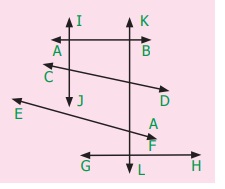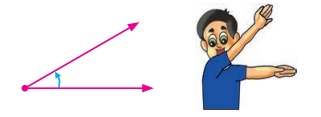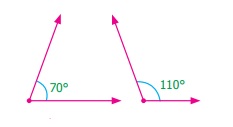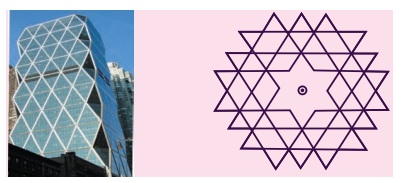Term 1 Chapter 5 | 7th Maths - Geometry | 7th Maths : Term 1 Unit 5 : Geometry
Chapter: 7th Maths : Term 1 Unit 5 : Geometry
Geometry
Chapter 5
GEOMETRY

Learning objectives
● To understand about adjacent angles, linear pair and vertically
opposite angles.
● To understand transversal.
● To identify the different types of angles formed by a pair of lines
wilth a transversal.
● To construct perpendicular bisector of a given line segment.
● To construct angle bisector of a given angle.
● To construct special angles such as 90°, 60°, 30° and 120° without
using protractor.
Recap
Lines
Let us recall the following concepts on lines and
points which we have learnt in class VI.
A line
extends along both directions without any end. A line AB is denoted by ![]() . Sometimes small letters like l, m, n and so on are used to denote lines.
. Sometimes small letters like l, m, n and so on are used to denote lines.

A line segment has two end points. The line segment
'AB' is represented by ![]() .
.

A Ray
is a line that starts from a point 'A' and extends without any end in a particular
direction passing through 'B' which is denoted by ![]() .
.

If two lines m and n are parallel, then we denote it as m||n. Parallel lines never intersect each other.

When two lines have a common point they are called
intersecting lines and that point is called
the point of intersection of the given two lines.

If three or more points lie on the same line, then
they are called collinear points; otherwise
they are called non-collinear points.

Try these
1. Complete the following statements.
(i) A line is a straight path that goes on endlessly in two directions.
(ii) A line segment is a line with two end points.
(iii) A ray is a straight path that begins at a point and goes on
and extends endlessly in the other direction.
(iv) The lines which intersect at right angles are perpendicular lines.
(v) The lines which intersect each other at a point are called Intersecting lines.
(vi) The lines that never intersect are called parallel lines.
2. Use a ruler or straightedge to draw each figure.
(i) line CD (ii) ray AB (iii) line segment MN

3. Look at the figure and answer the following questions.

(i) Which line is parallel to AB : GH
(ii) Name a line which intersect CD : IJ
(iii) Name the lines which are perpendicular to GH : KL
(iv) How many lines are parallel
to IJ
one line KL
(v) Will EF intersect AB? Explain.
NO EF intersect KL
Angles
Recall that an angle
is formed when two rays diverge from a common point. The rays forming an angle are
called the arms of the angle and the common
point is called the vertex of the angle. You have studied different types of angles, such
as acute angle, right angle, obtuse angle,
straight angle and reflex angle, in class
VI. We can summarize them as follows:
Acute angle
An angle whose measure is less than 90º is called
an acute angle.

Right angle
An angle whose measure is exactly 90º is called
a right angle.

Obtuse angle
An angle whose measure is greater than 90º is called
an obtuse angle.

Straight angle
An angle whose measure is exactly 180° is called
a straight angle.

Reflex angle
An angle whose measure is greater than 180° and
less than 360° is called a reflex angle.
Also, we have studied about related angles such
as complementary and supplementary angles in our previous class. Let us recall them.

Complementary angles
Two angles are called Complementary
angles if their sum is 90°.

Are the two angles given in the figure complementary?
Yes.
The pair of angles 35° and 55° are complementary, where the angle 35° is said to be the complement of the other angle 55° and vice versa.
Supplementary angles
Two angles are called Supplementary
angles if their sum is 180°.

Observe the sum of measures of the angles 70° and
110° given in the figure is 180°. When two angles are supplementary, each angle
is said to be the supplement of the other.
Try these
Choose the correct answer.
1. A straight angle measures
(a) 45°
(b) 90°
(c) 180°
(d) 100°
Answer : (c) 180°
2. An angle with measure 128° is called
____________ angle.
(a) a straight
(b) an obtuse
(c) an acute
(d) Right
Answer : (b) an obtuse
3. The corner of the A4 paper has
(a) an acute
angle
(b) a right
angle
(c) straight
(d) an obtuse
angle
Answer : (b) a right
angle
4. If a perpendicular line is bisecting
the given line, you would have two
(a) right
angles
(b) obtuse
angles
(c) acute
angles
(d) reflex
angles
Answer : (a) right
angles
5. An angle that measure 0° is called
_______.
(a) right
angle
(b) obtuse
angle
(c) acute
angle
(d) zero
angle
Answer : (d) zero angle
Introduction
We are familiar with complementary and supplementary
angles. Let us see some more related pairs of angles now.
MATHEMATICS ALIVE - GEOMETRY IN REAL LIFE

Beauty
of Angles in architecture and kolams
Related Topics